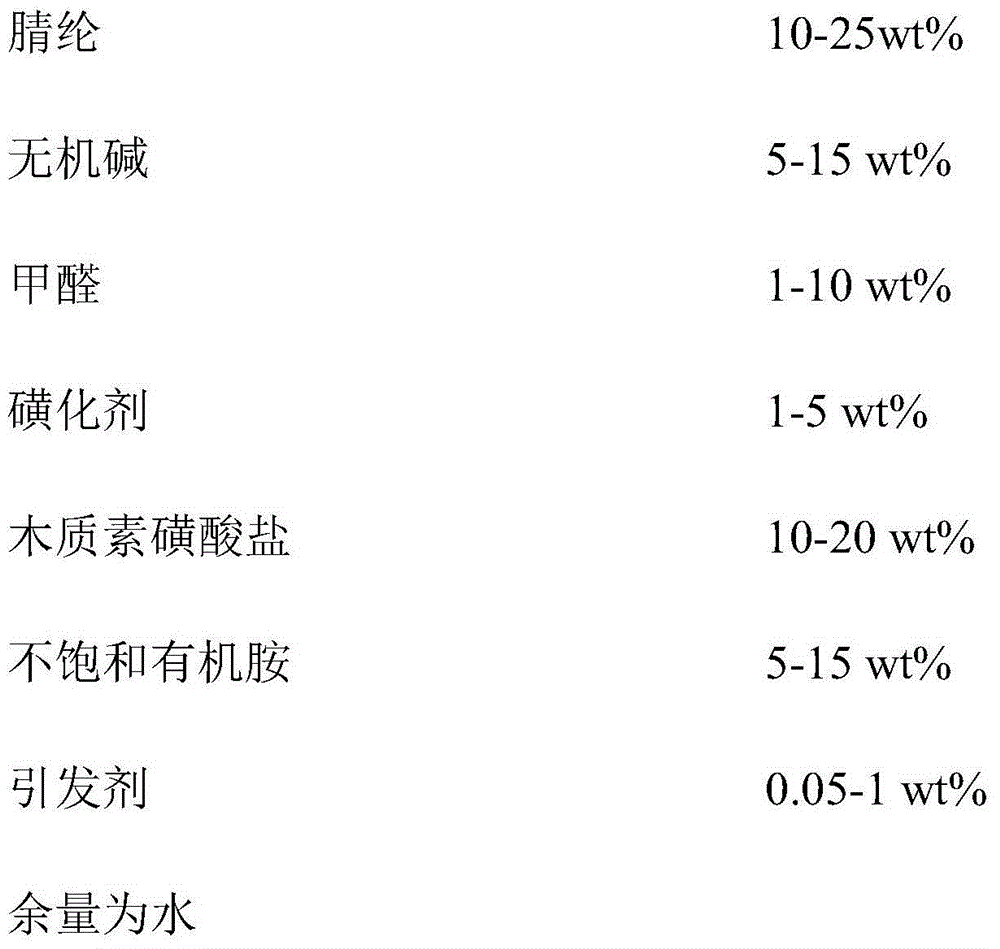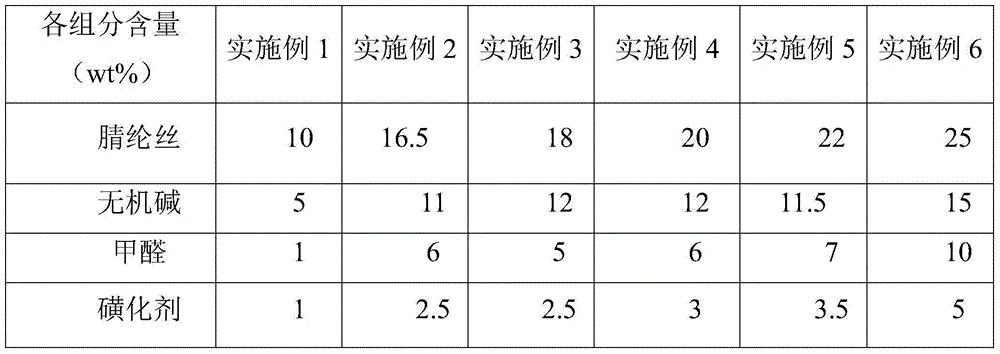Concrete synergist and preparation method thereof
A technology of concrete synergist and mixture, which is applied in the field of concrete synergist and its preparation, can solve the problems of poor environmental performance of the final product, difficulty in obtaining raw materials, environmental pollution, etc., achieve good compatibility, save cement consumption, reduce The effect of production costs
- Summary
- Abstract
- Description
- Claims
- Application Information
AI Technical Summary
Problems solved by technology
Method used
Image
Examples
Embodiment 1
[0030] The content of each component required for the reaction is shown in Table 1, wherein the inorganic base is sodium hydroxide, the sulfonating agent is sodium sulfite, the lignosulfonate is sodium lignosulfonate, and the unsaturated organic amine is diallyl base amine, the initiator is sodium persulfate.
[0031] (1) After adding acrylic fiber, sodium hydroxide and water into the reaction kettle, start stirring, and start to heat up, and react for 2 hours after the temperature reaches 78°C;
[0032] (2) Add formaldehyde and sodium sulfite to the reaction kettle, and keep the temperature at 85°C, and continue to react for 3 hours;
[0033] (3) Add sodium lignosulfonate and diallylamine in the reactor, start dripping the sodium persulfate solution that mass percentage concentration is 4% after adding, this sodium persulfate solution is made of described sodium persulfate and It is prepared with water; the dropping time is controlled at 1 hour, and the temperature is contro...
Embodiment 2
[0035] The content of each component required for the reaction is as shown in Table 1, wherein the acrylic fiber is the waste produced in the production or processing of the acrylic fiber, the inorganic base is potassium hydroxide, and the sulfonating agent is sodium bisulfite, lignosulfonate It is potassium lignosulfonate, the unsaturated organic amine is allylamine, and the initiator is potassium persulfate.
[0036] (1) After adding acrylic fiber, potassium hydroxide and water into the reaction kettle, start stirring, and start to heat up, and react for 5 hours after the temperature reaches 75°C;
[0037] (2) Add formaldehyde and sodium bisulfite to the reaction kettle, and keep the temperature at 90°C, and continue to react for 2 hours;
[0038] (3) add lignosulfonate potassium and allylamine in reactor, start to drop mass percent after adding and be the potassium persulfate solution that concentration is 6%, this potassium persulfate solution is made of described potassiu...
Embodiment 3
[0040] The content of each component required for the reaction is as shown in Table 1, wherein the acrylic fiber is or is the waste produced by other application manufacturers using acrylic fiber as the main raw material, the inorganic base is sodium hydroxide, and the sulfonating agent is sodium sulfite. The lignosulfonate is ammonium lignosulfonate, the unsaturated organic amine is triallylamine, and the initiator is ammonium persulfate.
[0041] (1) After adding acrylic fiber, sodium hydroxide and water into the reaction kettle, start stirring, and start to heat up, and react for 3 hours after the temperature reaches 80°C;
[0042] (2) Add formaldehyde and sodium sulfite to the reaction kettle, and keep the temperature at 100°C, and continue the reaction for 1 hour;
[0043] (3) Add ammonium lignosulfonate and triallylamine in the reactor, start to add dropwise mass percentage after adding and be the ammonium persulfate solution that concentration is 8%, this ammonium persu...
PUM
 Login to View More
Login to View More Abstract
Description
Claims
Application Information
 Login to View More
Login to View More - R&D
- Intellectual Property
- Life Sciences
- Materials
- Tech Scout
- Unparalleled Data Quality
- Higher Quality Content
- 60% Fewer Hallucinations
Browse by: Latest US Patents, China's latest patents, Technical Efficacy Thesaurus, Application Domain, Technology Topic, Popular Technical Reports.
© 2025 PatSnap. All rights reserved.Legal|Privacy policy|Modern Slavery Act Transparency Statement|Sitemap|About US| Contact US: help@patsnap.com



